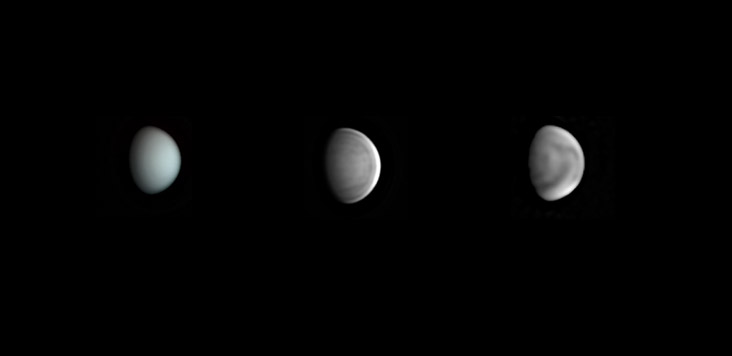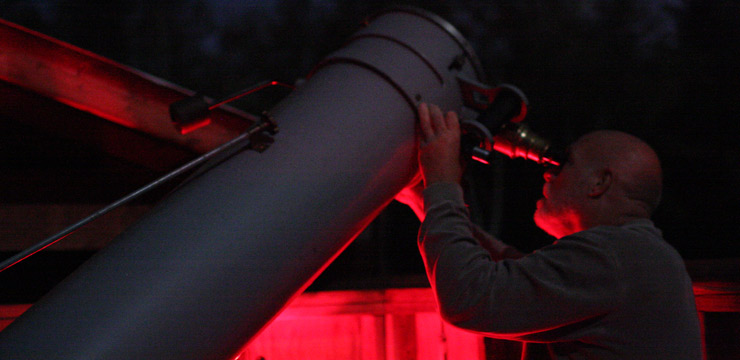
Seeing Venus in a Different Light
May 2023 :
The planet Venus is currently well placed in the western sky right after sunset. The best time to observe the planet is while it is still daylight since it will be higher in the sky, with less atmospheric turbulence. Use a GOTO telescope to find Venus an hour before sunset and just before sunrise. For many amateur astronomers, Venus appears rather featureless and not very interesting except for its phase. Therefore, some believe there is no reason to image Venus on a regular basis. Nothing can be further from the truth; we need to see the planet in a different light - namely the ultraviolet and infrared. These wavelengths are invisible to our eyes; however, todays CMOS planetary imaging cameras are rather sensitive to these wavelengths.
At ultraviolet wavelengths, Venus exhibits high altitude clouds of sulfur dioxide, sulfuric acid and other unknown absorbers. To image these cloud features an ultraviolet filter is required. An inexpensive specialized planetary imaging filter set is available from Astromania for only $77.99. The filter set includes an ultraviolet 350nm narrowband filter, infrared 685 longpass filter and methane 890nm narrowband filter. Our eyes are fine tuned to see the electromagnetic spectrum between 400nm to 700nm. Today’s CMOS chips are sensitive to wavelengths between 300nm to 400nm in the near ultraviolet. A Barlow lens and diagonal prism cannot be used when imaging Venus in the ultraviolet since these additional lenses and mirrors can potentially absorb precious ultraviolet photons. Simply screw the UV filter onto the nosepiece of the monochrome ZWO, QHY or Player One camera then attach it to the telescope at prime focus. A Schmidt-Cassegrain at least 8-inches (200mm) or larger in aperture is ideal for planetary imaging. The telescope must be tracking, however, autoguiding is not necessary and the telescope can even be mounted alt-azimuth. Focusing can be challenging especially in the ultraviolet. My technique is to reduce the screen size of the planet to 50% then focus until the circumference of the planet is as sharp as possible. The video is taken at 100% size and resolution. Adjust the exposure and gain so that the planet is slightly underexposed. The reason for this is that during post-processing if the video were not under-exposed the final image may appear over-exposed. For planetary imaging a 60 second video is typically taken with the free software packages Firecapture or Sharpcap. The reason a 60 second video is taken is because most planets show significant rotation if imaged for longer periods of time. The surface details on Mars, Jupiter and Saturn will appear blurry and smeared in videos longer than one minute. However, this is not true for Venus. Venus exhibits two central meridians, known as CMI and CMII. CMI is for the surface rotation and CMII is for atmospheric rotation. For Venus, I take a 300 second (5 minute) AVI video. The planet barely rotates during the five-minute exposure with the surface central meridian exhibiting no rotation whereas the atmospheric clouds only rotate 0.3 degrees. Firecapture has an autoguide and cut feature, which will keep the planet centered and reduce the region of interest resulting in a smaller file size. File sizes for planetary videos are typically in the gigabyte range. Once you have the video, import it into the free program Autostakkert for aligning and stacking then export the image into Registax for sharpening. Stack only 15% to 25% of the highest quality video frames. Further sharpening with AstraImage and Photoshop Elements is recommended. I typically do a quick Autostakkert and Registax processing in the field to see the quality of my video-processed image. The time it takes to capture, align, stack and sharpen an image is only 10 minutes (including five minutes to capture the video). If the image is of poor quality, simply take another video. I typically take three to five videos then choose the best-processed image. Import this image into AstraImage.
I use a Lucy-Richardson deconvolution function, which further enhances the Venetian clouds. The clouds appear dark against a white planet. Once you have deconvoluted the image in AstraImage, import the image into Photoshop or Photoshop elements. The high pass filter option further brings out details in the cloud structure. Increase the image size by 1.25x to 1.5x depending on the quality of the image. Save the file as a TIFF, PNG or JPG and you are finished.
Once you become proficient in imaging Venus in the ultraviolet, you will want to upgrade your ultraviolet filter. The best UV filters on the market are the Chroma UBessel and the Astrodon UVenus which both achieve a 98% bandpass from 320nm to 380nm whereas the Astromania only allows 80% bandpass at 350nm with some infrared leakage. The Chroma filter does not come cheap at $295 and is available from the manufacturer. Astrodon UVenus costs slightly less at $253. I now use the Chroma U Bessel filter exclusively and the difference is astounding. The dark clouds of Venus appear with much higher contrast and resolution. You get what you pay for.
The mid-latitude clouds of Venus become visible in infrared wavelengths. Monochrome planetary cameras such as the ZWO, QHY and Player One are sensitive to the near-infrared wavelengths from 700nm to 1000nm. The 685nm longpass filter from the Astromania filter set is therefore required. However, one needs to be deeper in the infrared to have better contrast with the mid-latitude clouds. The ZWO 850nm IR longpass filter costs only $22 and is strongly recommended. Follow the same procedures as for the ultraviolet. Take a 300 second (five minute) video using the 850nm IR longpass filter then process the video using Autostakkert, Registax, AstraImage, and Photoshop. The infrared camera gives more video frames therefore one can stack 25% to 33% of the highest quality frames.
There is a hidden treasure for deep-sky and planetary imaging unknown to most amateur astronomers- AstroSurface. Astrosurface is a free software package that aligns, stacks, sharpens, deconvolutes all in the same program. Tutorials are available on YouTube. Fortunately, the learning curve for this program is not very steep. I typically process UV and IR images of Venus using both Autostakkert/Registax and Astrosurface. The images turn out essentially equivalent in quality.
Planetary images taken today by amateur astronomers rival photographs from professional observatories fifty years ago. Therefore planetary images are of great scientific value. The Association of Lunar and Planetary Observers (ALPO) archives your images for amateur-professional collaboration (see www.alpo-astronomy.org). Send images to venus@alpo-astronomy.org. The Venus Section coordinator is Julius Benton PhD. The Planetary Virtual Observatory and Laboratory (PVOL) is a European database. Send images to pvol@ehu.eus. The hstjupiter@groups.io is another database for all the planets not only Jupiter. There is also ALPO- Japan email: alpo-obs@alpo-j.sakura.ne.jp. I send my planetary images to all these databases.
The Akatsuki (Japanese for “Dawn”) spacecraft launched by the Japanese Aerospace Exploration Agency entered orbit around Venus on Dec 7, 2015 and has since been continuously studying the atmosphere of Venus using several cameras in the visible, ultraviolet and infrared wavelengths. The Akatsuki Science Data archive has photos of the clouds of Venus in the ultraviolet and infrared that can complement amateur astronomer ground based images.
NASA has two missions in the works to study Venus. The DAVINCI (Deep Atmosphere Venus Investigation of Noble gases, Chemistry, and Imaging) mission is planned to launch in 2029 and will study the Venetian clouds. VERITAS (Venus Emissivity, Radio Science, InSAR, Topography, and Spectroscopy) is scheduled to launch in 2031 and will map the surface at higher resolution. The European Space Agency (ESA) plans to launch the EnVISION spacecraft in 2032, which is designed to study the atmospheric composition of Venus.
A private mission from Rocket Labs will launch a spacecraft called the Venus Life Finder (VLF) within the next year or so to study the clouds of Venus and attempt to confirm the presence of phosphine and other organic molecules. Phosphine has been in the news as a possible molecule from living organisms in the clouds of Venus.
In conclusion, Venus when imaged in the infrared and ultraviolet portion of the electromagnetic spectrum exhibits dynamic cloud features that are visible in a small telescope by amateur astronomers. Unlike deep-sky, planetary imaging is more reasonably priced and affordable. A ZWO, QHY, or Player One camera costs $299, the price of an average eyepiece. The Astromania filter set is only $78 and the ZWO 850nm IR filter is $22. Therefore for about $400 you can start imaging the planets “in a different light”.
Greg Shanos presented at the ALPO Virtual Conference: July 28, 2023
Related Topics




